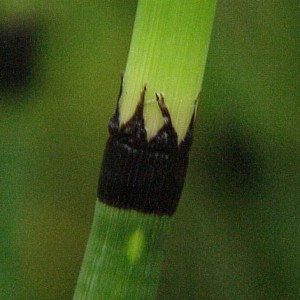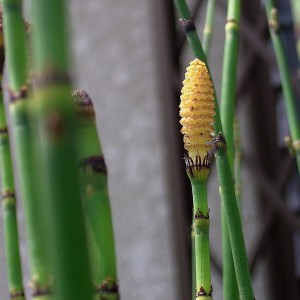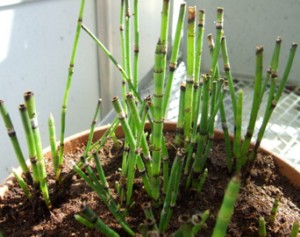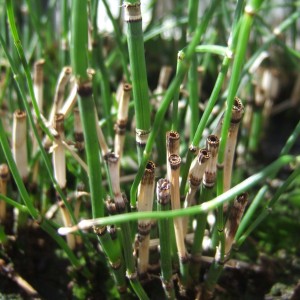Horsetail
The genus Equisetum
| Description | Horsetails are very primitive plants belonging to the genus Equisetum, vascular plants that reproduce by spores in a similar fashion to ferns. The plant consists of long, hollow, narrow stem segments with minisule, non-photosynthetic leaves. Many species are branched and have “bristles” radiating our from each stem segment. Horsetails have a fair range of size– some extinct prehistoric species were quite large and treelike. It is thought that the first horsetails arose in the late Devonian era. |
|---|---|
| Area | The 20 extant species of horsetails have a worldwide distribution. They typically live in moist, semi-aquatic areas, such around ponds, lakes, marshes, or rivers. |
| Special Characteristics |
Horsetails are known for their diverse chemistry. They contain high levels of silica, magnesium, potassium, multiple flavonoids, alkaloids (including traces of nicotene in some cases), saponins, and various other minerals. This diverse chemistry makes horsetail an interesting medicinal plant. Historically, it was used as a remedy for myriad conditions, including anemia, bleeding, depression, coughing, stomach ulcers, urinary problems, wound and bone healing, tuberculosis, and many more. The silicic acid in it is especially useful for encouraging calcium absorbtion. Horsetail is still used by some herbalists nowadays but only very carefully as it does contain some detrimental compounds. Horsetails are also important to aquatic ecosystems. The submerged portions of the stems provide habitats for numerous small organisms, and the detritus from decaying plants provides a food source for these organisms. In the Paleozoic, when Horsetail was most dominant, it probably played an even bigger role in more types of ecosystems. |
| Reproduction | Horsetails are perennial reproduce via spores instead of seeds. Fertile stems appear before the sterile ones and are small, pale, and unbranched. These stems form a cone-like, spore-producing structure at the top of the stem. Horsetails grow extensive rhizome systems and can be very difficult to eliminate should an infestation occur. |
| Trivia |
Despite its name, horsetail is toxic to horses (as well as humans and other animals in large quantities). It contains an enzyme thiaminase which interferes with thiamine (a B-complex vitamin) metabolism. When poisoning occurs from horsetail, especially in livestock, it is called “equisetosis”. Horsetails are often called “scouring rushes” because of their historical use of scouring metal cookwear. The stems are covered in small grains of silica, which are abrasive enough to clean metal. The background image for the site banner is horsetail. |
 |
 |
|
| The hollow stems are visible in this photo. | The leaves of Equisetum are small and non-photosynthetic.
Image from wikimedia commons. |
A spore-bearing cone on E. hyemale.
Image from wikimedia commons. |

